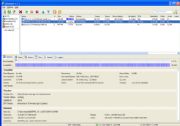BitTorrent is finding its way into your wireless routers, NAS drives, media streamers, and more. We explain how it works and why you might want it.
Comcast wants to kill it, your next wireless router will probably have it built-in, and you can use it to download the entire GeoCities archive. BitTorrent has come a long way since its public release on July 2, 2001, but unless you're a regular media pirate, you probably haven't used it much. Read on to find out how it works and to clear up a few common misconceptions about it.
Is BitTorrent Legal?
 No court has found the BitTorrent protocol inherently unlawful. But using BitTorrent to trade copyright-protected files will likely put you on the wrong side of the law. A Princeton study published earlier this year estimated that only 1 percent of the files in a sample pool of 1021 files shared on BitTorrent were legal, so it's no wonder that many people assume that BitTorrent itself is illegal. To ensure that your downloads stay on the right side of the law, stick to trackers that are dedicated to sharing free content, such as ClearBits and LegitTorrents.info.
No court has found the BitTorrent protocol inherently unlawful. But using BitTorrent to trade copyright-protected files will likely put you on the wrong side of the law. A Princeton study published earlier this year estimated that only 1 percent of the files in a sample pool of 1021 files shared on BitTorrent were legal, so it's no wonder that many people assume that BitTorrent itself is illegal. To ensure that your downloads stay on the right side of the law, stick to trackers that are dedicated to sharing free content, such as ClearBits and LegitTorrents.info.
Though using BitTorrent is legal, several Internet service providers try to monitor users' traffic and clamp down on their BitTorrent usage. This is called "traffic shaping," and it can be highly inconvenient for torrent downloaders. Read "Elude Your ISP's BitTorrent Blockade" for more information.
How Does BitTorrent Work?
Normally, if you want to download a file from a Web site, you just click a few links in your Web browser and your system will start saving the file to your default Downloads folder. The server hosting the file sends you the file, bit by bit, until you have the whole thing.
Bandwidth isn't free, however, so transferring the file costs someone money . The more popular a file is, the more servers and bandwidth the hosts will need to continue distributing it. That's why so many downloads sites are saturated by obnoxious ads--the sites need to pay their bandwidth bills. As the world swaps larger and larger files, such as high-definition videos, high-resolution photos, and higher-quality music, the bandwidth bill grows and grows.
BitTorrent eases the monetary strain on individual file hosts by motivating downloaders to upload, too. If you're downloading a movie via BitTorrent, you'll start out downloading chunks of the movie. Once you've collected a few pieces of the movie, you'll continue to download the rest of the file, but you'll also start uploading the pieces you have to other people trying to download the same movie.
![]() LinuxTracker lists the files, sizes, and number of seeders and leechers for each torrent.For example, suppose that a movie file is split into four chunks named A, B, C, and D. One computer (the "seeder") has all four chunks, another computer has ABC, another has BC, and the last one has D.
LinuxTracker lists the files, sizes, and number of seeders and leechers for each torrent.For example, suppose that a movie file is split into four chunks named A, B, C, and D. One computer (the "seeder") has all four chunks, another computer has ABC, another has BC, and the last one has D.
As soon as you receive A, you can start sharing it with the other computers that don't have chunk A. The seeder computer can then use its bandwidth for sharing segment D, which is more scarce.
Also, the BitTorrent protocol rewards people who upload more files and upload files more quickly. If your uploading speeds are high, the client directs more people to send you missing chunks of your files.
Generally, BitTorrent makes it easier for users to share files at higher download speeds, but you may find that your Internet connection slows down while your BitTorrent client is open. That's because your bandwidth is being used not just for ongoing downloads, but also for simultaneous uploads. When your system has downloaded all of the chunks of a file, you don't need to worry about assembling the parts yourself.
The first step in downloading something with BitTorrent is to find a torrent tracker site, which is a searchable index of .torrent files. Each .torrent file contains the "metadata" for the file you're looking for; basically, the .torrent file tells your BitTorrent client how to identify the different chunks of each file and how they fit together.
The .torrent file isn't the actual movie, song, or other file you were looking to download. It's more like a decoder ring that sniffs out the different chunks of your file, then assembles them correctly once they're all downloaded.
If you're looking to download a Linux distribution, for example, you can just stop by LinuxTracker, find the torrent listing that matches what you're looking for, and download the corresponding .torrent file. Once the .torrent file is downloaded, you open it in a BitTorrent client such as Vuze or µTorrent (aka uTorrent), and you'll start connecting to everyone else who's uploading and downloading that file.
Just remember that if there are no "seeders" for that particular file, you won't be able to complete the download, because no one will have a full copy of the file. This doesn't happen often with popular files, but if there's only one person seeding your file, you might find your download has stopped because the seeder's PC shut down for the night.
What's the Best BitTorrent Client?
The official BitTorrent client is called "BitTorrent," the term "BitTorrent" usually refers more generally to the protocol used to transfer files, not necessarily the particular client app you're using to download the those files.
Dozens of BitTorrent clients exist. You can download torrents straight from your browser if you use Opera, you can run BitTorrent from a Java app with BitLet, and a short-lived iPhone app called IS Drive even let you use BitTorrent from your phone. For use with a PC, however, a few apps stand out from the pack.
 µTorrent is a lightweight, speedy BitTorrent client. µTorrent--widely identified as "uTorrent," though the character µ is a lowercase Greek mu (equivalent to an m in English), and not a lowercase Greek upsilon [?] (equivalent to a u in English)--is a lightweight-yet-full-featured client app offered by BitTorrent, Inc. itself. It's easy enough to use, very good for managing a library of torrents, and includes plenty of networking tweaks for advanced users. µTorrent doesn't manage your media library or include a built-in player, so it's great if you want to download media files but then use separate apps to organize and play them.
µTorrent is a lightweight, speedy BitTorrent client. µTorrent--widely identified as "uTorrent," though the character µ is a lowercase Greek mu (equivalent to an m in English), and not a lowercase Greek upsilon [?] (equivalent to a u in English)--is a lightweight-yet-full-featured client app offered by BitTorrent, Inc. itself. It's easy enough to use, very good for managing a library of torrents, and includes plenty of networking tweaks for advanced users. µTorrent doesn't manage your media library or include a built-in player, so it's great if you want to download media files but then use separate apps to organize and play them.
 Vuze can be your one-stop shop for HD video.On the other hand, if you want to use the same app to download, organize, play back, and even share your media over the network, check out Vuze, an ad-supported BitTorrent client which handles all of the above functions in one app. The fee-based Vuze Plus service includes DVD burning and antivirus features for an $25/year.
Vuze can be your one-stop shop for HD video.On the other hand, if you want to use the same app to download, organize, play back, and even share your media over the network, check out Vuze, an ad-supported BitTorrent client which handles all of the above functions in one app. The fee-based Vuze Plus service includes DVD burning and antivirus features for an $25/year.
 Use Miro to manage your media from multiple sources. Miro is an all-in-one client similar to Vuze, but it includes more-robust features for pulling audio and video from other sources besides torrents--podcasts, RSS feeds, YouTube subscriptions, and more.
Use Miro to manage your media from multiple sources. Miro is an all-in-one client similar to Vuze, but it includes more-robust features for pulling audio and video from other sources besides torrents--podcasts, RSS feeds, YouTube subscriptions, and more.
For micromanaging your downloads while you're on the go, both µTorrent and Vuze have remote-access options that, when activated, let you log in to your home PC and manage your downloads with a Web app.
Why Does My NAS Drive/Wireless Router/Media Streaming Box Have BitTorrent?
Over the past two years, we've been seeing apps with BitTorrent embedded in them finding their way into a handful of devices, including NAS drives, media streamers, and wireless routers. It's a fairly natural fit: Many people use BitTorrent to download movies, music, and TV shows, so these devices can download, store, and stream to your PC or TV without your having to leave the PC on all the time.
The actual client software included differs from device to device, but most of them use a Web app nested within the device's management page. Buffalo, for example, has licensed the official BitTorrent app, so the Web app is essentially a modified version of the µTorrent Web client. Keep in mind that you still have to find the actual .torrent files yourself.
Is BitTorrent Safe?
Well, that depends.
In our article "The 17 Most Dangerous Places on the Web," we wrote that illegal file-sharing sites can leave you open to malware infection. Because so many people use BitTorrent for swapping copyrighted material, it also qualifies as a security risk.There's no guarantee that anyone has screened the files shared via BitTorrent, and some pirates might try to make money by hiding malware in your downloads and then selling access to your computer, or by adding your PC to a botnet of infected PCs.
Still, nothing about the file-sharing protocol itself makes BitTorrent more dangerous than any other method of transferring files. If your system gets infected with malware from a file downloaded via BitTorrent, the culprit is the tainted file, not the fact that you downloaded it via BitTorrent. Had you opened the same file as an e-mail attachment, it would have introduced the same infection.
Whether you use BitTorrent to download OpenOffice or each episode of The Office, there are a few things you can do to help yourself stay safe while using it:
- When you search a tracker site for a .torrent file, read the comments about a file before downloading it. If a popular file is infected with something, someone else has probably already downloaded it, found the malware, and posted a message warning others.
- Vet your torrent trackers thoroughly. Lots of Web sites contain fake torrent search listings. If it seems as though real people aren't posting on the site, don't use it.
- Don't use BitTorrent without some form of antivirus. Even a free antivirus app like Microsoft Security Essentials, if properly updated, can help keep you somewhat safe.





No comments:
Post a Comment